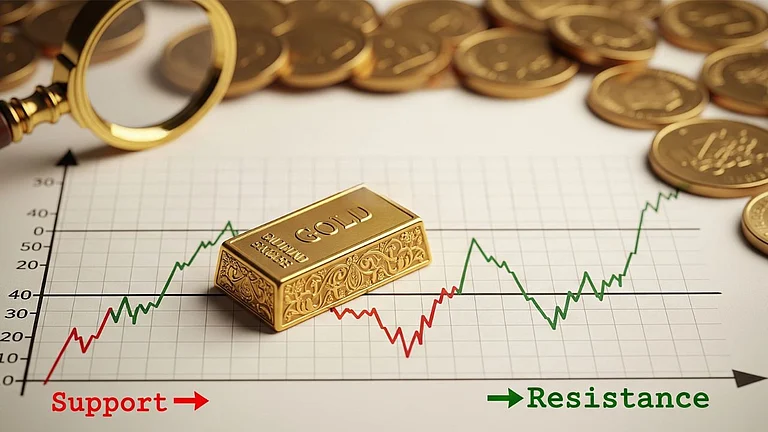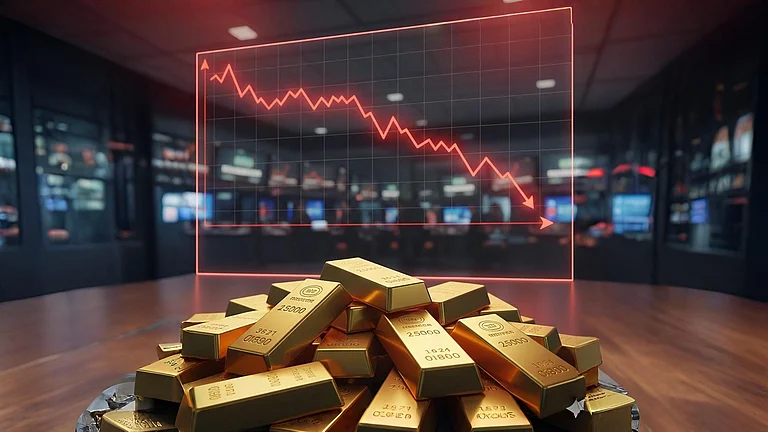
Summary of this article
Powell’s dovish tone at Jackson Hole points to an imminent Fed rate cut
A softer dollar could revive FII flows into domestic equities
Gold may shine brighter as investors turn to safe-haven assets amid falling US Dollar
Indian bonds might find support, as RBI possibly will get more room to cut rates
US Federal Reserve Chair Jerome Powell’s speech at Jackson Hole, Wyoming, United States, on August 22, 2025, sounded dovish, which means a rate cut is likely imminent in the Federal Open Market Committee’s (FOMC) next meeting in September 2025. Powell has been consistent in defending the Fed’s outlook on the US economy by refusing to be cowed down by US President Donald Trump’s relentless public criticisms for not cutting rates fast enough.
Though, this dovish signal does not seem as a reaction to Trump’s pressure. Instead, it seems to be coming from Powell’s own reading of where the economy stands.
“Our policy rate is now 100 basis points closer to neutral than it was a year ago, and the stability of the unemployment rate and other labour market measures allows us to proceed carefully as we consider changes to our policy stance. Nonetheless, with policy in restrictive territory, the baseline outlook and the shifting balance of risks may warrant adjusting our policy stance,” Powell hinted.
John Mauldin, CEO of Mauldin Economics, in a note said, "We read Powell’s speech at Jackson Hole. It was modestly dovish. Basically, after he talked about real inflation risks, a few sentences later he indicated they would make a rate cut."
Turning to inflation, Powell said higher tariffs have begun to push up prices in some categories of goods. “The effects of tariffs on consumer prices are now clearly visible. We expect those effects to accumulate over the coming months with high uncertainty about both timing and amounts.”
However, the Fed Chair also said that the effects will be relatively short-lived and a one-time shift in the price level.
“Given that the labour market is not particularly tight and faces increasing downside risks, that outcome (wage-price dynamics from tariffs) does not seem likely,” he added.
Wall Street Cheers Powell’s Speech
Wall Street investors cheered Powell’s speech as the US market’s benchmark indices ended higher on August 22. The blue-chip Dow Jones Industrial Average jumped 1.89 per cent to end the session at its lifetime closing high at 45,631.74. The tech-heavy Nasdaq Composite, too, climbed 1.88 per cent higher to 21,496.54. Similarly, the S&P 500 rose 1.52 per cent to close at 6,466.91.
While the rally was broad-based, megacap technology stocks were at the forefront. Chipmaker Nvidia rose 1.72 per cent, and Facebook parent Meta Platforms gained 2.12 per cent. Google parent Alphabet jumped 3.04 per cent, e-commerce giant Amazon advanced 3.10 per cent, and the Elon Musk-led Tesla surged 6.22 per cent.
What Fed’s Rate Cut Means for India’s Capital Markets
If the US Federal Reserve does cut rates in its rate-setting panel's next meeting, its effects will trickle down to emerging economies like India as well. Even before the rate cuts happen, the markets will price it in when it goes into trade next week, solely on the basis of Powell's dovish hints.
Equities
When the Fed cuts rates, typically it weakens the US dollar. The US Dollar Index, after Powell's speech, came sharply down by 0.90 per cent to 97.73.
Weakness in the US dollar, in turn, often prompts institutional investors to shift their investments into emerging markets like India.
VK Vijayakumar, Chief Investment Strategist, Geojit Investments, said in a note, “In the near term Foreign Institutional Investors (FIIs) may reduce their selling, since the dollar is weakening, responding to rate cut expectations from the Fed in September.
Gold
For gold prices, which are already trading near its record highs, could surge even further on a weakening US dollar.
Prathamesh Mallya, DVP Research Non-Agri Commodities & Currencies, Angel One, explains that the US dollar and commodities share an inverse correlation. In simple words, when the US dollar weakens, it typically augurs well for gold investors as the demand for the safe haven metal increases.
Kaynat Chainwala, AVP-Commodity Research, Kotak Securities, too, said, “The dovish shift in Powell’s messaging could provide support to gold.”
Bonds
Powell’s dovish remarks are expected to provide support to Indian bonds, according to Vishal Goenka, co-founder of IndiaBonds.com.
In an earlier note, Goenka said that Powell’s hint towards imminent rate cuts would be followed by weakness in the US dollar and will help cushion the recent pressure on the Indian rupee. He also said that an actual rate cut in September would give the Reserve Bank of India (RBI) room to follow suit. “The action of the rate cut by the Fed in September will actually open the door for the RBI to follow suit in the face of slowing credit and economic growth,” he said in a note.
In the medium term, he suggested that this scenario is favourable for investors willing to take on “duration risk”.
“These are good levels to add duration to a fixed-income portfolio as we remain in a cyclical down cycle for interest rates,” Goenka said.
Duration risk is basically the risk that comes with holding long-term bonds. The longer the bond, the more its price reacts when interest rates change. In case rates go up, the value of these bonds falls. But if rates are cut, the same long-term bonds can give better returns.















